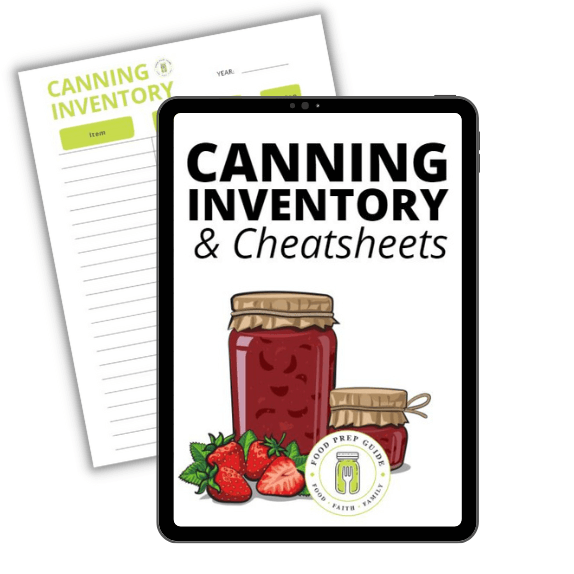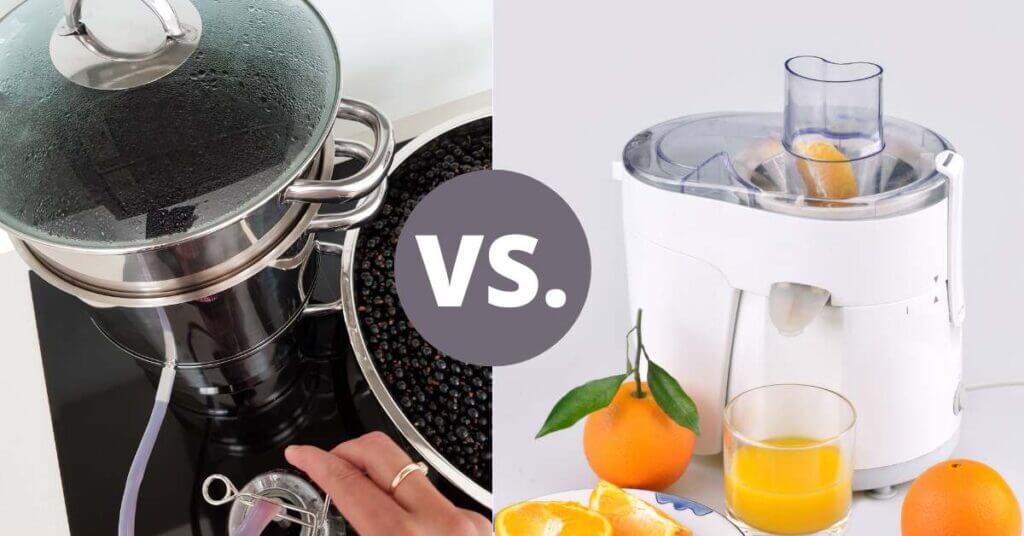When I was a kid, I couldn’t wait until June. Because school was out, obviously, but also because our family always went berry-picking.
Berry-picking meant gobbling up way too many strawberries in the field and then enjoying strawberry shortcake and whipped cream that night and homemade strawberry jam for months.
Yum!
My adult self still loves eating berries in the field and piling whipped cream on my shortcake and slathering sweet strawberry goodness on my English muffins.
But the aftermath of berry-picking—aka endless sessions of hulling strawberries? Not so much.
Enter steam juicing.
I’ve written before about how to use a steam juicer, but today I want to talk about why a steam juicer is a game-changer when it comes to canning (and making strawberry jelly!).
Each type of juicer has its pros and cons, which we’ll discuss.But, in the battle of steam juicer vs juice extractor, a steam juicer is the clear winner for my canning needs.
What Is the Difference Between a Steam Juicer and Juice Extractor?
If you’ve never juiced before, you may not even be aware that there’s more than one way to turn life’s lemons into lemonade.
Before I discovered steam canning, I thought all juicing machines were just a variation on that squeezy thing you put lemons into to mix up a refreshing summertime beverage.
I just assumed that all juicers squeezed fruit with varying amounts of force until they got as much juice out as possible.
While it’s true that juice extractors mostly work this way (with some variation), steam juicers work much differently.
Steam is substituted for manual force to break down the cell walls within the fruit and bring forth the delicious juice.
To answer the question—Which juicing method is best?—let’s take a closer look at each type of juicer.
Steam Juicer for Canning
How a Steam Juicer Works
As I said above, a steam juicer uses steam to coax forth luscious juice from fruit.
- Includes 11.75 quart steamer insert, 4 quart juice container, 7.25 quart water pot; rubber tube and clamp.
- Extremely versatile, multipurpose, professional gauge stainless steel steamer juicer and steamer.
- The most effective and simple way to make your own pure, natural juices.
- An oven roaster, stove top cooker and covered baker/server. Roast meats, steam vegetables and seafood.
- Use steamer in base pot or use Base pot with encapsulated base to provide even heating for great stove top cooking including induction stove tops.
- Oven safe to 400˚F/ 205˚c.
- Recipes and instruction booklet includ
Prices pulled from the Amazon Product Advertising API on:
Product prices and availability are accurate as of the date/time indicated and are subject to change. Any price and availability information displayed on [relevant Amazon Site(s), as applicable] at the time of purchase will apply to the purchase of this product.
You boil some water in a pot at the bottom of the juicer, and the steam rises through a colander basket holding berries, grapes, plums, etc. As the fruit steams, it releases juice that’s collected in a reservoir.
Pros
So why does it matter how you’ve convinced the fruit to give up its juice? What are the benefits of a steam juicer?
In my opinion, the most important benefit is the savings on labor and time when using steam instead of other extraction methods.
There’s no need to do anything other than rinse and lightly chop the fruit beforehand—and even that part is optional.
You don’t have to peel it, you don’t have to remove stones or pits, and you don’t have to remove grapes from their vines!
Watch:
None of the stuff you put in the basket will make its way into the juice, which saves an incredible amount of labor when you’re hip deep in an orchard-load of fruit.
I’m assuming you have plenty of other chores to do, so this time savings is a crucial benefit.
And, because the mess in the basket doesn’t make it into the juice, you end up with beautiful, clear juice that doesn’t require extra work to strain it.
There’s less mess to deal with, and the steam juicer is a breeze to clean since it has so few small or moving parts.
Cons
How about the disadvantages of a steam juicer?
The primary drawback of using steam to juice your fruit is that steam, of course, is generated by heat. So, you’re essentially cooking the fruit somewhat—in other words, no raw juice.
This isn’t a problem for me, but if your end goal is raw juice with live enzymes, a steam juicer won’t get you there.
Juice Extractor for Canning
How a Juice Extractor Works
Juice extractors use manual force to, in effect, pummel the juice out of your fruit.
- Healthy, homemade juice in seconds- juice a variety of fruits and vegetables. Juicer is easy to assemble with extra-large pulp bin. Juice cup not included
- Extra-large 3 inch feed chute fits whole fruits and vegetables - Fit a whole apple, a peeled orange or a handful of kale. Less precutting, and more continuous juicing for fresh fruit juice, vegetable juice, or nutrient packed celery juice
- Easy to clean - Removable parts are dishwasher safe and BPA free
- Powerful electric motor for maximum juice: 800w of power can turn a dense beet into smooth juice in seconds
- *Cup not inclu
Prices pulled from the Amazon Product Advertising API on:
Product prices and availability are accurate as of the date/time indicated and are subject to change. Any price and availability information displayed on [relevant Amazon Site(s), as applicable] at the time of purchase will apply to the purchase of this product.
Whether you use an extractor that spins, squeezes, crushes, or grinds your fruit, the end result is juice that’s been drawn out by means other than heat.
Pros
Because no heat is involved in this type of extraction, one of the main benefits of a juice extractor juice is that it’s raw with live enzymes.
If this matters to you, then a juice extractor is the way to go.
Cons
One of the primary disadvantages of a juice extractor is the mess left behind. Forcefully extracting juice leaves heaps of pulp and fibers you’ll need to clean from the machine’s moving parts.
The juice itself will also end up pulpy, so you’ll probably want to strain it before using it.
There’s also more work in prepping the fruit before extraction as previously mentioned. You’ll need to hull berries, destone plums and peaches, core apples, and remove grapes and berries from the vine.
Most juice extractors are also expensive, bulky, difficult to clean, and some can be mind-numbingly slow.
Steam Juicer vs. Juice Extractor: A Canner’s Perspective
Now that we’re familiar with both types, which is better—a juicer or extractor?.
To determine which style is best for you, answer this question:
Why are you juicing?
- Are you on a raw diet and looking for the highest quality organic juice? Then extracting juice without heat is the way to go.
- Do you occasionally make lemonade or orange juice from store-bought citrus, or otherwise need a juicer for small batches of juicing? If that’s the case, a small, manual juice extractor may be sufficient.
However, if you’re a home canner or like to stock jelly and fruit syrups during berry-picking season, I’d recommend a steam juicer.

The canning benefits of a steam juicer are numerous:
- A steam juicer requires less labor both before (less prep) and after (less straining of the juicer plus easier cleanup).
- A steam juicer stores easily, which means one less bulky appliance to store. A steam juicer also requires fewer attachments.
- A quality steam juicer is usually cheaper than a good juice extractor.
- Steam juicing doesn’t require electricity, assuming you have a gas stove.
- Steam juicers can pull double duty by steam-blanching vegetables.
Since I discovered steam juicing, I won’t go back to regular juice extraction, especially when it comes to canning. It makes a potentially dreadful chore much less labor-intensive!











